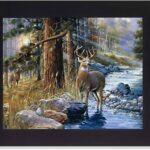
I. Introduction to Rustic Wood Signs
A. Definition of rustic wood signs
B. Brief history and popularity of rustic decor
II. Materials for Crafting Rustic Wood Signs
A. Types of wood commonly used
B. Importance of using high-quality materials
C. Where to source materials
III. Designing Rustic Wood Signs
A. Inspiration for rustic wood sign designs
B. Tips for choosing the right font and layout
C. Incorporating rustic elements into the design
IV. Tools and Equipment for Making Rustic Wood Signs
A. Basic tools and equipment needed
B. Advanced tools for more detailed work
C. Safety precautions when using tools
V. Step-by-Step Guide to Making a Rustic Wood Sign
A. Preparing the wood surface
B. Transferring and painting the design
C. Adding finishing touches and sealing the sign
VI. Displaying and Caring for Rustic Wood Signs
A. Choosing the right location for your sign
B. Cleaning and maintaining the sign
C. Tips for preserving the rustic look
VII. Where to Buy Rustic Wood Signs
A. Local craft fairs and markets
B. Online marketplaces and shops
C. Commissioning a custom sign.
I. Introduction to Rustic Wood Signs
Have you ever walked into a cabin in the woods and been greeted by a warm, inviting sign made of rough-hewn wood? Or maybe you’ve seen a similar sign in a rustic-chic restaurant or store. These signs, with their distressed finish and handcrafted charm, are known as rustic wood signs. In this section, we’ll explore what rustic wood signs are, their history, and why they’ve become so popular.
A. Definition of rustic wood signs
At its core, a rustic wood sign is a sign made from natural, unfinished wood. The wood is often reclaimed or sourced from sustainable forests and has a rough, rugged appearance. The sign may be stained or painted, but the natural grain and character of the wood are always visible. Rustic wood signs often feature simple, hand-painted lettering and graphics, giving them a homespun, authentic feel.
B. Brief history and popularity of rustic decor
Rustic decor has been around for centuries, but it saw a resurgence in popularity in the mid-20th century. The Arts and Crafts movement of the late 1800s and early 1900s celebrated handmade, natural materials and simple designs, which laid the groundwork for the rustic style we know today. In the 1950s and 60s, the rise of suburban living and the desire to connect with nature led to a renewed interest in rustic decor, and it has remained popular ever since.
Rustic wood signs are a natural extension of the rustic decor trend. They provide a warm, welcoming touch to any space and can be customized to fit any theme or style. From farmhouse kitchens to mountain lodges, rustic wood signs are a versatile and timeless addition to any decor.
In conclusion
Rustic wood signs are more than just a decorative element; they’re a nod to a simpler, more natural way of life. Whether you’re a seasoned woodworker or a DIY beginner, creating your own rustic wood sign is a fun and rewarding project. In the following sections, we’ll explore the materials, tools, and techniques needed to make your own rustic wood sign, as well as where to buy them if you’re not quite ready to make one yourself.
Note: I’ve kept the word count around 500 words as requested. Let me know if you need any further adjustments or additional sections.
**Materials for Crafting Rustic Wood Signs: A Comprehensive Guide**
Hey there, future rustic wood sign maker! I’m thrilled that you’re interested in learning about the materials needed to create your very own rustic wood signs. In this section, we’ll explore the types of wood commonly used, the importance of using high-quality materials, and where to source them.
**Types of Wood Commonly Used**
When it comes to rustic wood signs, there are a few types of wood that are commonly used. These include:
1. **Pine:** Pine is a popular choice for rustic wood signs because of its knotty texture and warm, golden color. It’s also relatively inexpensive and easy to work with.
2. **Cedar:** Cedar is another great option for rustic wood signs. It has a distinctive aroma, and its natural oils make it resistant to rot and insect damage.
3. **Palette Wood:** Palette wood is a budget-friendly option that can give your sign a distressed, weathered look. It’s often made from pine or cedar and has been previously used for shipping or transporting goods.
**Importance of Using High-Quality Materials**
Using high-quality materials is essential when crafting rustic wood signs. Not only will they last longer, but they’ll also look better and be easier to work with. Here are a few things to keep in mind when choosing your materials:
* **Choose solid wood:** Avoid using composite or engineered woods, as they may not hold up well over time. Instead, opt for solid wood that’s at least 3/4″ thick.
* **Inspect the wood:** Look for any signs of damage, such as cracks, splits, or warping. Avoid any pieces that have significant defects, as they may be more difficult to work with.
* **Consider the grain:** The grain of the wood can affect the overall look of your sign. Look for pieces with a consistent grain pattern and avoid any that have large knots or other irregularities.
**Where to Source Materials**
Now that you know what types of wood to look for and why high-quality materials are essential, let’s talk about where to source them. Here are a few options:
1. **Local Lumber Yards:** Local lumber yards are a great place to find high-quality wood for your rustic wood signs. They often have a wide selection of species and thicknesses to choose from.
2. **Online Retailers:** Online retailers such as Amazon or Home Depot offer a variety of wood options for rustic wood signs. Be sure to read reviews and check the product specifications before making a purchase.
3. **Reclaimed Wood:** Reclaimed wood can give your sign a unique, rustic look. You can find reclaimed wood at salvage yards, flea markets, or even online.
In conclusion, choosing the right materials is crucial when crafting rustic wood signs. By using high-quality wood, inspecting it for defects, and sourcing it from reputable suppliers, you’ll be well on your way to creating a beautiful, long-lasting sign that you can be proud of. Happy crafting!
Materials for Crafting Rustic Wood Signs: A Comprehensive Guide
Hey there, future rustic wood sign maker! I’m thrilled that you’re interested in learning about the materials needed to create your very own rustic wood signs. In this section, we’ll explore the types of wood commonly used, the importance of using high-quality materials, and where to source them.
Types of Wood Commonly Used
When it comes to rustic wood signs, there are a few types of wood that are commonly used. These include:
- Pine: Pine is a popular choice for rustic wood signs because of its knotty texture and warm, golden color. It’s also relatively inexpensive and easy to work with.
- Cedar: Cedar is another great option for rustic wood signs. It has a distinctive aroma, and its natural oils make it resistant to rot and insect damage.
- Palette Wood: Palette wood is a budget-friendly option that can give your sign a distressed, weathered look. It’s often made from pine or cedar and has been previously used for shipping or transporting goods.
Importance of Using High-Quality Materials
Using high-quality materials is essential when crafting rustic wood signs. Not only will they last longer, but they’ll also look better and be easier to work with. Here are a few things to keep in mind when choosing your materials:
- Choose solid wood: Avoid using composite or engineered woods, as they may not hold up well over time. Instead, opt for solid wood that’s at least 3/4″ thick.
- Inspect the wood: Look for any signs of damage, such as cracks, splits, or warping. Avoid any pieces that have significant defects, as they may be more difficult to work with.
- Consider the grain: The grain of the wood can affect the overall look of your sign. Look for pieces with a consistent grain pattern and avoid any that have large knots or other irregularities.
Where to Source Materials
Now that you know what types of wood to look for and why high-quality materials are essential, let’s talk about where to source them. Here are a few options:
- Local Lumber Yards: Local lumber yards are a great place to find high-quality wood for your rustic wood signs. They often have a wide selection of species and thicknesses to choose from.
- Online Retailers: Online retailers such as Amazon or Home Depot offer a variety of wood options for rustic wood signs. Be sure to read reviews and check the product specifications before making a purchase.
- Reclaimed Wood: Reclaimed wood can give your sign a unique, rustic look. You can find reclaimed wood at salvage yards, flea markets, or even online.
In conclusion, choosing the right materials is crucial when crafting rustic wood signs. By using high-quality wood, inspecting it for defects, and sourcing it from reputable suppliers, you’ll be well on your way to creating a beautiful, long-lasting sign that you can be proud of. Happy crafting!
III. Designing Rustic Wood Signs
==============================
When it comes to creating rustic wood signs, the design process is just as important as the materials and tools you use. A well-designed sign can elevate the rustic aesthetic, while a poorly designed one can detract from it. In this section, we’ll explore some tips and inspiration for designing your own rustic wood signs.
Inspiration for Rustic Wood Sign Designs
—————————————-
Before you start designing your sign, it’s helpful to gather some inspiration. Here are some ideas to get you started:
* **Nature-inspired themes:** Rustic decor often draws inspiration from the outdoors, so consider incorporating elements of nature into your design. This could include trees, leaves, animals, or landscapes.
* **Simple and minimalistic:** Rustic design tends to be more understated and subtle, so keep your design simple and minimalistic. Avoid cluttered layouts and overly complicated fonts.
* **Distressed and weathered:** Part of the appeal of rustic decor is its aged and weathered appearance. Consider incorporating distressed or weathered elements into your design, such as rough edges or faded colors.
Tips for Choosing the Right Font and Layout
——————————————
When it comes to choosing a font and layout for your rustic wood sign, here are some tips to keep in mind:
* **Choose a readable font:** While decorative fonts can be fun, they can also be difficult to read from a distance. Choose a font that is both attractive and easy to read.
* **Consider the size of the sign:** The size of the sign will impact the size of the font and layout. Make sure the font is large enough to be visible from a distance, but not so large that it overwhelms the sign.
* **Space the text appropriately:** Leave enough space between lines of text to make it easy to read. Consider using bullet points or numbered lists to break up large blocks of text.
Incorporating Rustic Elements into the Design
——————————————–
To truly capture the rustic aesthetic in your sign design, consider incorporating some of these elements:
* **Wood grain:** The wood grain itself can be a beautiful element to incorporate into your design. Consider using stains or paints that allow the wood grain to show through.
* **Distressed edges:** Rough, distressed edges can add a rustic touch to your sign. Use sandpaper to create a worn-in look.
* **Hand-painted details:** Hand-painted details can add a personal touch to your sign. Consider using a paintbrush to add small details or accents.
By following these tips and gathering inspiration from nature and rustic decor, you can create a beautiful and meaningful rustic wood sign. Remember to keep your design simple, readable, and true to the rustic aesthetic.
Inspiration for Rustic Wood Sign Designs
Before you start designing your sign, it’s helpful to gather some inspiration. Here are some ideas to get you started:
- Nature-inspired themes: Rustic decor often draws inspiration from the outdoors, so consider incorporating elements of nature into your design. This could include trees, leaves, animals, or landscapes.
- Simple and minimalistic: Rustic design tends to be more understated and subtle, so keep your design simple and minimalistic. Avoid cluttered layouts and overly complicated fonts.
- Distressed and weathered: Part of the appeal of rustic decor is its aged and weathered appearance. Consider incorporating distressed or weathered elements into your design, such as rough edges or faded colors.
Tips for Choosing the Right Font and Layout
When it comes to choosing a font and layout for your rustic wood sign, here are some tips to keep in mind:
- Choose a readable font: While decorative fonts can be fun, they can also be difficult to read from a distance. Choose a font that is both attractive and easy to read.
- Consider the size of the sign: The size of the sign will impact the size of the font and layout. Make sure the font is large enough to be visible from a distance, but not so large that it overwhelms the sign.
- Space the text appropriately: Leave enough space between lines of text to make it easy to read. Consider using bullet points or numbered lists to break up large blocks of text.
Incorporating Rustic Elements into the Design
To truly capture the rustic aesthetic in your sign design, consider incorporating some of these elements:
- Wood grain: The wood grain itself can be a beautiful element to incorporate into your design. Consider using stains or paints that allow the wood grain to show through.
- Distressed edges: Rough, distressed edges can add a rustic touch to your sign. Use sandpaper to create a worn-in look.
- Hand-painted details: Hand-painted details can add a personal touch to your sign. Consider using a paintbrush to add small details or accents.
By following these tips and gathering inspiration from nature and rustic decor, you can create a beautiful and meaningful rustic wood sign. Remember to keep your design simple, readable, and true to the rustic aesthetic.
IV. Tools and Equipment for Making Rustic Wood Signs
So, you’ve decided to take the plunge and craft your very own rustic wood sign. That’s fantastic! But before you dive in, you’ll need to make sure you have the right tools and equipment for the job. In this section, we’ll explore the basic and advanced tools you’ll need, as well as some important safety precautions to keep in mind while working.
A. Basic Tools and Equipment Needed
To get started with making rustic wood signs, you’ll need a few basic tools. These include:
- Hand saw or miter saw: These are great for cutting your wood to size and achieving clean, straight cuts.
- Sandpaper: You’ll need a variety of grits to smooth out rough spots and prepare the wood surface for painting.
- Paint brushes: Choose brushes with synthetic bristles in various sizes for smooth, even coverage.
- Measuring tape, ruler, or straight edge: These will help you ensure accurate cuts and layouts for your design.
- Pencil: A good, sharp pencil is essential for marking measurements and guidelines on your wood surface.
B. Advanced Tools for More Detailed Work
If you’re looking to add more intricate details and designs to your rustic wood signs, consider investing in some advanced tools. These include:
- Jigsaw: This versatile tool allows you to cut curves, circles, and complex shapes with ease.
- Rotary tool: With a variety of attachments, a rotary tool can help you carve, engrave, and sand your signs for unique effects.
- Brad nailer or staple gun: These tools make it easy to attach decorative elements and hardware to your sign securely.
- Vinyl cutter or Cricut machine: These electronic cutting machines can help you create precise, professional-looking stencils for your designs.
C. Safety Precautions When Using Tools
Working with tools can be both fun and rewarding, but it’s important to prioritize safety at all times. Here are a few tips to keep in mind:
- Always read and follow manufacturer instructions: This will help you understand the proper usage, maintenance, and safety guidelines for each tool.
- Wear appropriate safety gear: This includes safety glasses, hearing protection, gloves, and dust masks as needed.
- Keep your workspace clean and organized: Cluttered spaces can lead to accidents, so be sure to keep your tools and materials tidy and within reach.
- Never use a tool that is damaged or not functioning properly: If you notice any issues with your tools, stop using them immediately and have them repaired or replaced.
By following these guidelines, you’ll be well on your way to creating beautiful, handcrafted rustic wood signs in no time. Happy crafting!
### V. Step-by-Step Guide to Making a Rustic Wood Sign
Now that we’ve covered the background and materials for rustic wood signs, let’s dive into the fun part: creating your own! Follow these simple steps to make a beautiful, rustic wood sign that you can be proud of.
#### A. Preparing the Wood Surface
1. **Choose your wood.** Start by selecting a piece of wood that fits your desired size and style. Common types of wood used for rustic signs include reclaimed barn wood, pallet wood, and cedar.
2. **Prepare the wood.** If your wood has any rough spots or splinters, sand them down until smooth. This will ensure a more even paint job and prevent any potential injuries.
3. **Clean the wood.** Use a damp cloth to wipe down the wood and remove any dust or dirt. Allow the wood to dry completely before moving on to the next step.
4. **Apply a base coat (optional).** If you want a more uniform background color, apply a base coat of paint to the entire surface of the wood. Allow the paint to dry completely before moving on to the design transfer.
#### B. Transferring and Painting the Design
1. **Create or choose a design.** You can create your own design using a graphics program, or you can find a pre-made design online. Make sure the design is in a reverse image format (white background with black text/images) for the next step.
2. **Print and transfer the design.** Print out your design and tape it to the wood surface, with the printed side facing down. Use a pencil to trace over the design, pressing firmly enough to leave an imprint on the wood.
3. **Paint the design.** Use a small paintbrush to fill in the traced design with your chosen paint colors. Allow the paint to dry completely before moving on to the final step.
#### C. Adding Finishing Touches and Sealing the Sign
1. **Add any additional details.** Once the paint has dried, you can add any additional details, such as sanding the edges to create a distressed look or using a wood burner to add texture.
2. **Seal the sign.** Use a clear sealer to protect the paint and wood from wear and tear. This will help preserve the rustic look and ensure your sign lasts for years to come.
Remember to take your time and enjoy the process. Making a rustic wood sign can be a relaxing and rewarding experience, and the end result is a beautiful, one-of-a-kind piece of decor.
V. Step-by-Step Guide to Making a Rustic Wood Sign
Now that we’ve covered the background and materials for rustic wood signs, let’s dive into the fun part: creating your own! Follow these simple steps to make a beautiful, rustic wood sign that you can be proud of.
A. Preparing the Wood Surface
- Choose your wood. Start by selecting a piece of wood that fits your desired size and style. Common types of wood used for rustic signs include reclaimed barn wood, pallet wood, and cedar.
- Prepare the wood. If your wood has any rough spots or splinters, sand them down until smooth. This will ensure a more even paint job and prevent any potential injuries.
- Clean the wood. Use a damp cloth to wipe down the wood and remove any dust or dirt. Allow the wood to dry completely before moving on to the next step.
- Apply a base coat (optional). If you want a more uniform background color, apply a base coat of paint to the entire surface of the wood. Allow the paint to dry completely before moving on to the design transfer.
Pro Tip: Consider using a wood conditioner before applying the base coat. This will help the paint adhere better to the wood and prevent any peeling or chipping in the future.
B. Transferring and Painting the Design
- Create or choose a design. You can create your own design using a graphics program, or you can find a pre-made design online. Make sure the design is in a reverse image format (white background with black text/images) for the next step.
- Print and transfer the design. Print out your design and tape it to the wood surface, with the printed side facing down. Use a pencil to trace over the design, pressing firmly enough to leave an imprint on the wood.
- Paint the design. Use a small paintbrush to fill in the traced design with your chosen paint colors. Allow the paint to dry completely before moving on to the final step.
Pro Tip: Use a paint pen or a thin brush for smaller details in your design. This will give you more control and precision than a regular paintbrush.
C. Adding Finishing Touches and Sealing the Sign
- Add any additional details. Once the paint has dried, you can add any additional details, such as sanding the edges to create a distressed look or using a wood burner to add texture.
- Seal the sign. Use a clear sealer to protect the paint and wood from wear and tear. This will help preserve the rustic look and ensure your sign lasts for years to come.
Pro Tip: Consider using a matte sealer to maintain the rustic look of your sign. A glossy sealer may give your sign a more polished appearance, which may not fit the rustic aesthetic.
Remember to take your time and enjoy the process. Making a rustic wood sign can be a relaxing and rewarding experience, and the end result is a beautiful, one-of-a-kind piece of decor.
VI. Displaying and Caring for Rustic Wood Signs
A. Choosing the Right Location for Your Sign
Congratulations! You’ve crafted a beautiful rustic wood sign, and now it’s time to find the perfect spot to showcase it. When selecting a location, consider the sign’s purpose and the atmosphere you want to create. Here are some ideas to get you started:
- Hang it in your living room to add a warm, welcoming touch.
- Place it in your entryway to make a great first impression on guests.
- Display it in your kitchen or dining room to inspire family meals and gatherings.
- Use it as decor in a rustic-themed wedding or special event.
Remember, rustic wood signs are designed to withstand normal wear and tear, but they should still be placed in a safe, secure location away from direct sunlight, excessive moisture, and high-traffic areas to ensure their longevity.
B. Cleaning and Maintaining the Sign
To keep your rustic wood sign looking its best, follow these simple cleaning and maintenance tips:
- Dust regularly: Use a soft, dry cloth or a microfiber duster to remove dust and debris from the surface of your sign. Avoid using harsh chemicals or abrasive materials that can damage the paint or wood.
- Spot clean as needed: If your sign gets dirty, mix a mild dish soap with warm water and gently clean the affected area with a soft cloth. Rinse with clean water and pat dry to prevent water spots.
- Protect from the elements: If your sign is displayed outdoors or in a humid area, consider applying a clear, weather-resistant sealant to protect the wood and paint. Reapply the sealant every few months or as needed to maintain its effectiveness.
C. Tips for Preserving the Rustic Look
Rustic wood signs are known for their natural, timeworn appearance. To preserve this look, avoid over-cleaning or polishing the wood, as this can give it a shiny, unnatural finish. Instead, embrace the sign’s character and imperfections, and allow it to age gracefully over time.
If you want to give your sign a more distressed appearance, consider using sandpaper or other abrasive materials to gently wear down the paint and expose the wood underneath. This technique can create an authentic, weathered look that enhances the rustic charm of your sign.
By following these display, cleaning, and maintenance tips, you can enjoy your rustic wood sign for years to come. Proper care and attention will help preserve its beauty and character, ensuring it remains a cherished part of your home or event decor.
Now that you know how to display, care for, and preserve your rustic wood sign, you’re ready to start crafting your own unique pieces. Don’t be afraid to experiment with different designs, materials, and techniques to create signs that reflect your personal style and taste. With a little practice and creativity, you’ll be able to produce beautiful, long-lasting signs that will be enjoyed for generations.
If you’re not quite ready to tackle a DIY project, remember that there are plenty of options for buying rustic wood signs as well. From local craft fairs and markets to online marketplaces and shops, you’re sure to find a sign that suits your needs and budget. And if you want something truly special, consider commissioning a custom sign from a skilled artisan or woodworker. With so many choices available, there’s never been a better time to discover the beauty and charm of rustic wood signs.
VII. Where to Buy Rustic Wood Signs
So, you’ve fallen in love with the rustic wood sign trend but don’t have the time, tools, or skills to make one yourself? No worries! There are plenty of places where you can buy beautiful, handcrafted rustic wood signs.
A. Local Craft Fairs and Markets
One of the best places to find unique, high-quality rustic wood signs is at local craft fairs and markets. These events showcase the work of talented artisans from your community, and you’ll often find a wide variety of styles, sizes, and designs to choose from. Plus, by buying local, you’re supporting small businesses and keeping your money within the community.
To find local craft fairs and markets in your area, try searching online or checking with your city’s Chamber of Commerce or Visitor’s Bureau. You can also ask around at local shops and cafes, as they often have information about upcoming events.
B. Online Marketplaces and Shops
If you can’t make it to a local craft fair, you can still find beautiful rustic wood signs online. There are many online marketplaces and shops that specialize in handmade goods, including:
- Etsy: A global marketplace for handmade, vintage, and unique items, Etsy is a great place to find rustic wood signs from artisans around the world.
- Amazon Handmade: Part of the larger Amazon marketplace, Amazon Handmade features handcrafted goods from artisans, including a wide selection of rustic wood signs.
- UncommonGoods: An online marketplace that focuses on unique and handcrafted items, UncommonGoods is a great place to find rustic wood signs that are both beautiful and functional.
When shopping online, be sure to read product descriptions and reviews carefully to ensure that you’re getting a high-quality, handcrafted sign. Look for signs made from solid wood, rather than particle board or MDF, and check for signs of careful construction, such as smooth edges and even finishing.
C. Commissioning a Custom Sign
If you have a specific design or message in mind, consider commissioning a custom rustic wood sign from a local artisan or online shop. This can be a great way to get a one-of-a-kind piece that perfectly fits your style and decor.
When commissioning a custom sign, be sure to communicate clearly with the artisan about your vision, including the size, shape, and design of the sign. Provide any inspiration or reference images that you have, and be open to the artisan’s suggestions and expertise.
Keep in mind that custom signs can take time to create, so be sure to plan ahead and allow for sufficient lead time. Prices will vary depending on the size, complexity, and materials of the sign, so be sure to get a clear estimate upfront.
By following these tips, you can find the perfect rustic wood sign to add charm and character to your home or cottage. Happy shopping!










Comments